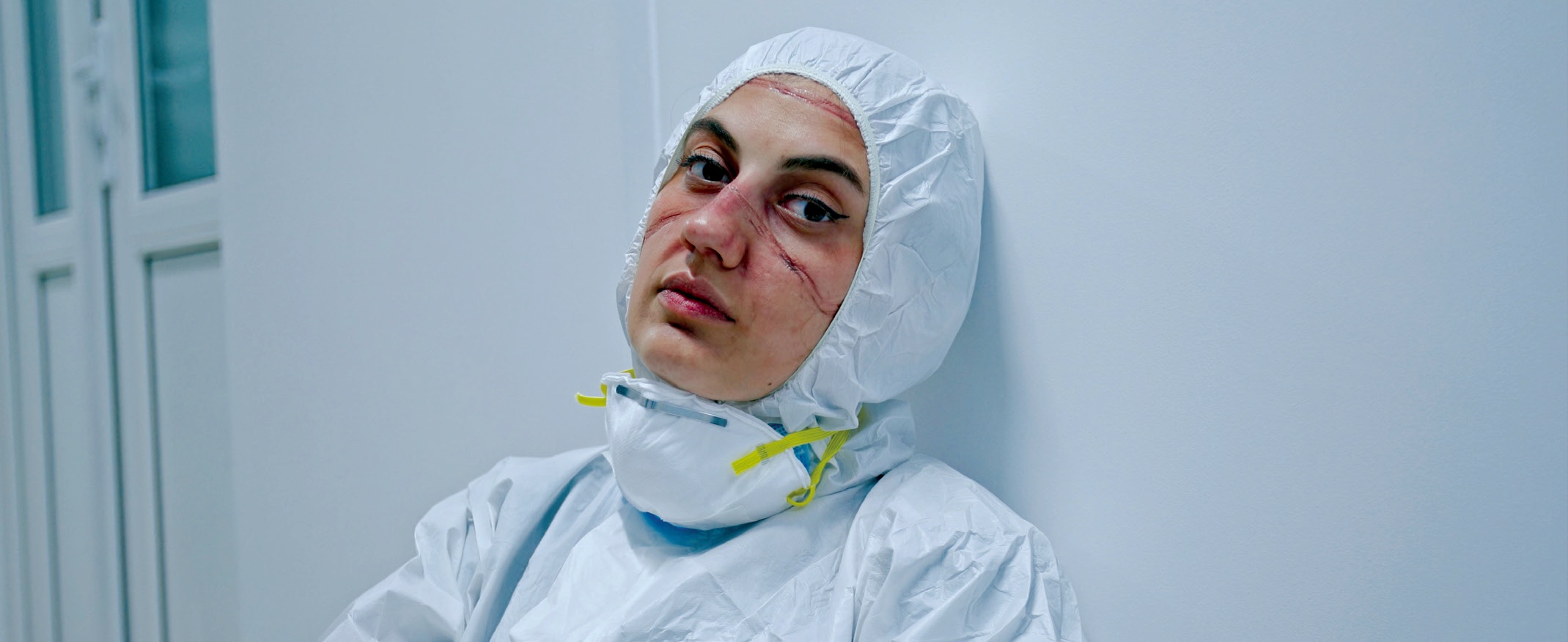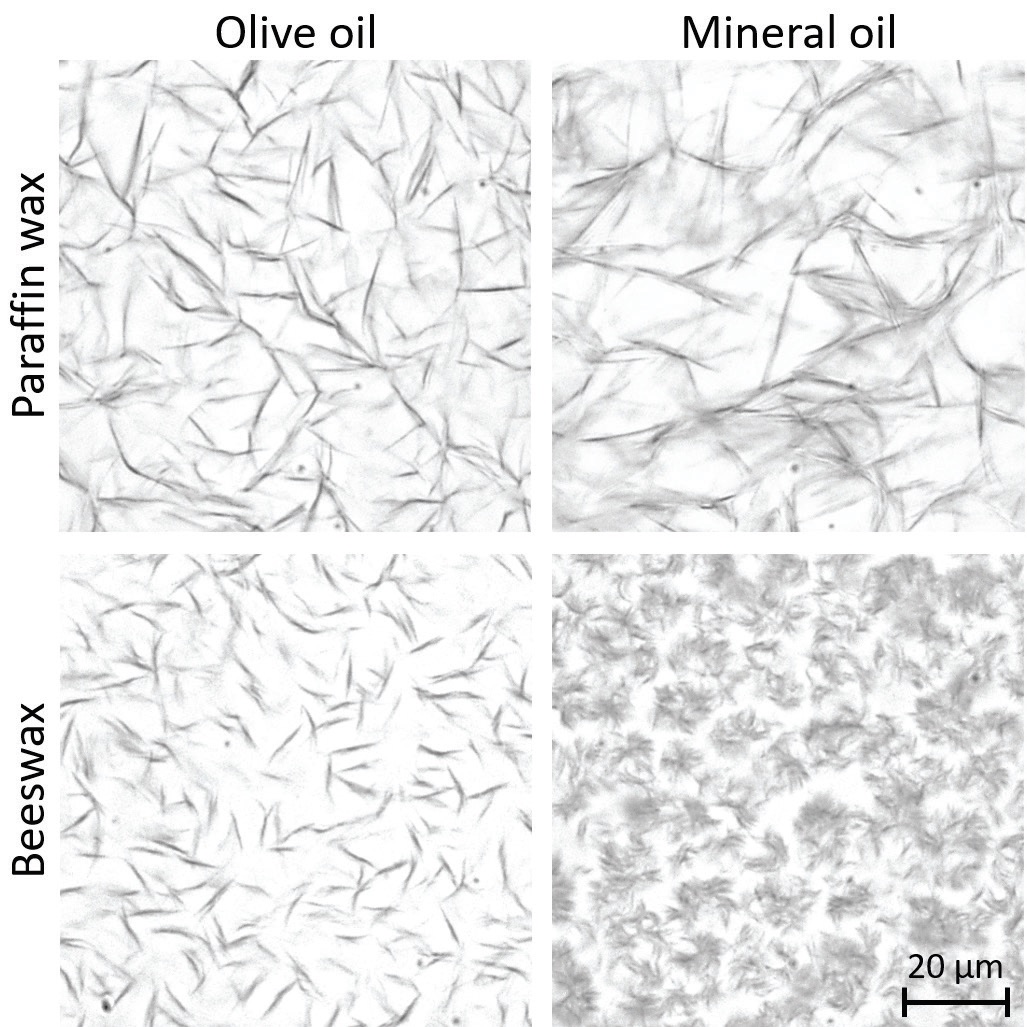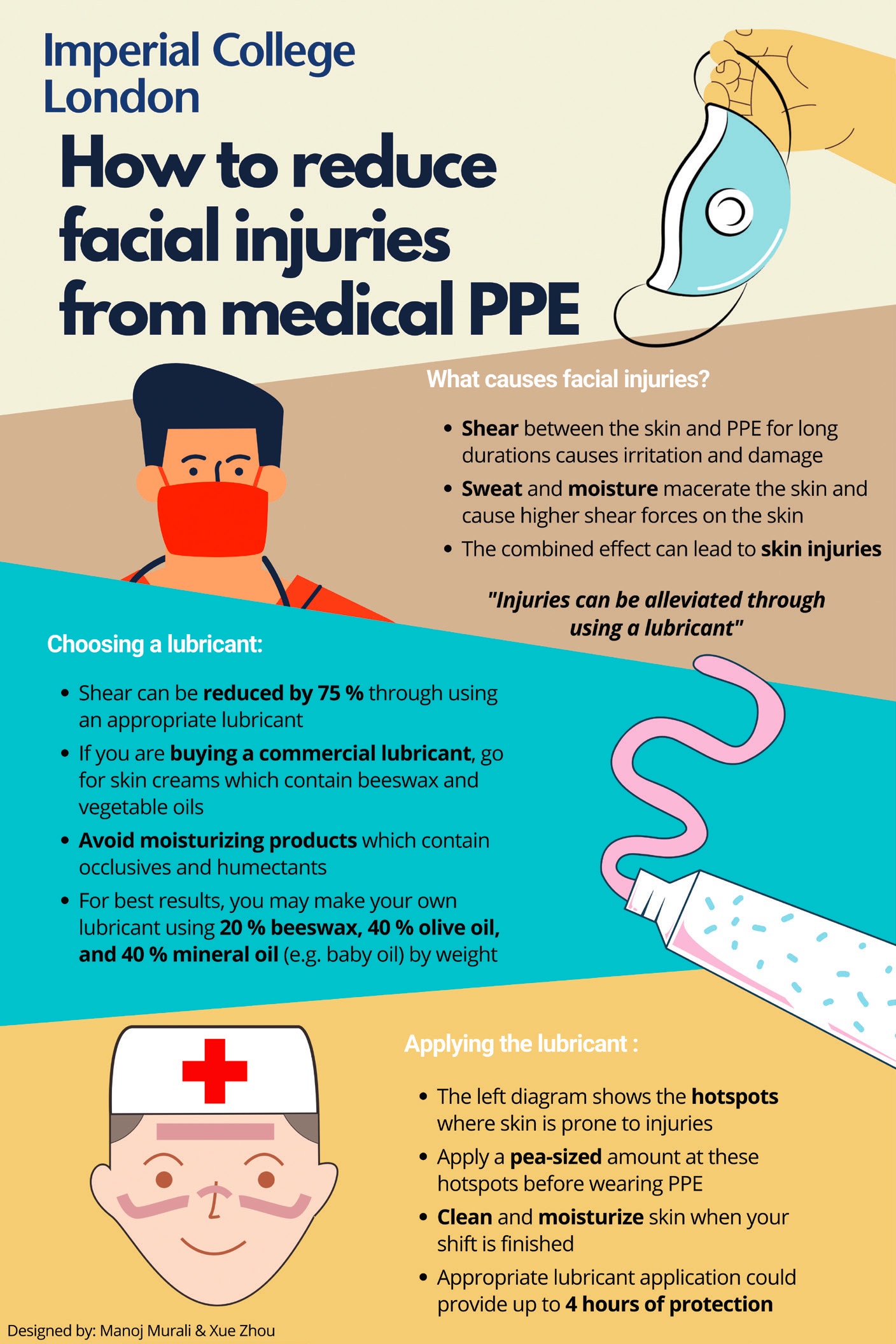TLT: How did you come across the PPE-induced skin injuries problem suffered by COVID-19 frontline medics?
Yap and Murali: During the height of the COVID-19 pandemic in April 2020, the Biotribology team at Imperial College London, led by Dr. Marc Masen, noticed a huge number of media reports on healthcare workers suffering from awful facial injuries (
see Figure 1). This was caused by the need to wear PPE for extended hours beyond the recommended usage time. The skin injuries not only cause pain and discomfort among medics but may potentially provide a dermal pathway for bacterial and viral infection.
Due to our prior experience on pressure-induced skin injuries research, we immediately recognized this to be a skin tribology problem. The only advice available was to apply petroleum jelly at 30-minute intervals, which would not be possible whatsoever in a COVID-19 ward setting where you simply cannot remove PPE with any frequency. Having seen the problem, there was a need to improve the medical recommendations given to healthcare workers to avoid these injuries.
As tribologists, we wanted to make use of our expertise in solving this problem for healthcare workers who have been risking their lives to combat the pandemic. The Imperial College COVID-19 Response Fund allowed us to put money toward testing and other resources. From there, we gathered a team of around 30 engineers and clinicians to accelerate the research of possible solutions, which could alleviate PPE-related skin injuries.
TLT: How are these PPE-induced skin injuries related to tribology?
Yap and Murali: Prolonged use of tight-fitting PPE such as goggles, visors and respirator masks among COVID-19 frontline medics can cause various skin injuries (e.g., contact dermatitis, urticaria, skin tears, blisters and pressure ulcers). If we observe the facial skin injuries among medics closely (
see Figure 1), you will find that these injuries mainly develop at the nose bridge, cheek bones and forehead. This is because shear stresses and strains tend to concentrate at bony prominences. Although wearing PPE can introduce both normal and shear loads on our skin, our skin is robust against normal loads but vulnerable to shear loads. The shear load is caused by the static friction that prevents the PPE from sliding against our skin. Excessive shear on the skin surface can cause significant tissue deformation and cellular distortion, leading to injuries. At the same time, shear loading reduces blood perfusion and the transcutaneous oxygen level in our skin. This weakens the integrity of the tissue, making our skin more prone to injury. Therefore, the key to alleviating PPE-induced skin injury is by minimizing the shear or friction at the skin-PPE interface.
 Figure 1. COVID-19 frontline medic who suffers from skin injuries due to prolonged use of PPE.
TLT: Please describe your work on alleviating skin injuries among frontline medics.
Figure 1. COVID-19 frontline medic who suffers from skin injuries due to prolonged use of PPE.
TLT: Please describe your work on alleviating skin injuries among frontline medics.
Yap and Murali: After our initial push for research, the possible solutions were clear: (1.) Redesign PPE to better distribute shear forces and (2.) apply a lubricant at the skin-PPE interface to reduce friction. The first solution addresses the problem at the source and, however, requires a significant change in design and production for manufacturers. Since our project is time-sensitive research involving a global pandemic, it is of utmost importance that our solution is both cost-effective and can be implemented rapidly. Therefore, significance was placed on the second solution.
We initiated the first phase of the work in May 2020. The focus was on finding a commercially available lubricant that could reduce shear at the skin-PPE interface. This involved testing of over 20 shortlisted skin creams and evaluating their friction reduction efficacy in vivo on the volar forearm using a tribometer. The sliding counterface was made of polydimethylsiloxane (PDMS) to replicate a material commonly used in PPE as a compliant seal that interfaces with skin. The maximum static coefficient of friction was measured both immediately after the application of the lubricant and also four hours after application; this provided insights into its performance over time to ensure that the lubricity of these products can last over the extended shift of healthcare workers.
This study suggested that skin creams that consist of wax-oil mixtures make a good lubricant. These lubricants are greasy and not absorbed by skin, therefore they can maintain a long-lasting protective layer between skin and PPE. This is opposite to how we normally define a good skin cream, which should be easily absorbed by skin and ideally leave no residue on the skin surface. The results of this study were published in the PLOS ONE journal (click
here) and circulated among healthcare workers in the National Health Service to have an immediate impact.
Following our findings on the superior performance of wax-oil lubricants, some questions arose. For example, what ratio of wax:oil works best, and how is the performance of natural and synthetic waxes and oils different from one another? This prompted the second phase of the project in September 2020. The focus of this phase was on developing an optimal wax-oil lubricant that can provide long-lasting low static friction between skin and PPE. Four skin-safe base ingredients, namely beeswax, paraffin wax, olive oil and mineral oil, were chosen to prepare various wax-oil lubricants combinations. Beeswax and olive oil represent ingredients for a natural system while paraffin wax and mineral oil represent that of a synthetic system. The test protocols were similar to the
in vivo sliding test described in phase one and involved a study with seven subjects to evaluate the lubricants.
TLT: What were the main findings from this research?
Yap and Murali: In general, we found that the minimum friction occurs at around 20 wt% wax, regardless of the types of wax-oil combinations. Interestingly, the lubricating mechanism of wax-oil lubricants is analogous to that of industrial greases. Waxes function as thickeners by manifesting extensive crystal networks with plenty of free volumes in it (
see Figure 2). These free volumes help retain oils in the sliding contact, contributing to good lubrication. Beeswax makes a better thickener than paraffin wax due to the higher derecrystallization temperature, which helps maintain its crystal structure at skin surface temperature (34 C). Different wax-oil combinations give different wax morphologies. It was found that the friction of a wax-oil lubricant is highly dependent on the wax morphology, for example, spherical dendritic wax structures show lower friction than the needle-like structures. In order for a lubricant to provide long-lasting lubricity, the oil absorbability of PPE materials, in this case PDMS, also needs to be taken into consideration. For example, PDMS can absorb mineral oil much faster than olive oil due to the high chemical affinity of PDMS for mineral oil. Therefore, the use of mineral oil-based lubricant alone is not advisable as the high oil absorption rate can lead to lubricant starvation at the sliding interface. Further information can be found in our publication in the Scientific Reports journal (click
here).
 Figure 2. Wax morphology of various wax-oil combinations. Figure courtesy of Imperial College London.
Figure 2. Wax morphology of various wax-oil combinations. Figure courtesy of Imperial College London.
TLT: What challenges did you encounter during this project?
Yap and Murali: A tribology experiment usually employs destructive testing techniques such as wear tests to characterize surface damage and failure. Such techniques are not suitable for skin tribology research, which often involves
in vivo testing. Experiments on people require ethics approval. Not only does the design of test protocols need to accommodate in vivo testing, but also the selection of materials needs to avoid the spawn of adverse medical conditions such as allergic reactions on test subjects. In this research, for example, the initial plan of adding polytetrafluoroethylene microparticles, which are commonly found in commercial anti-aging skincare products, into our lubricants was aborted as many countries have started to ban their use. This limits the application of a wide range of conventional tribology solutions, which are commonly used in industrial settings.
Furthermore, skin is a highly complex material. Even with meticulous controls, the interpersonal differences in contact and friction behaviors are often large due to variations in hydration level, sebum level and mechanical properties. Due to the poor repeatability, an
in vivo skin tribology experiment often requires a large sample size to enable inferential statistical analysis such as hypothesis testing. The recruitment of participants for a time-sensitive research during the national lockdown in a pandemic was a huge challenge. We had considered the possibility of using an artificial skin as a substitute to real human skin—however, most commercially available products fail to replicate the tribological properties of real skin.
TLT: What are the most effective solutions that you would recommend to reduce PPE-induced skin injuries among healthcare workers?
Yap and Murali: We summarized our advice for medics in a poster (
see Figure 3). In our opinion, the most effective solution for healthcare workers is to apply a generous amount of wax-oil lubricant at the skin-PPE interface to avoid injuries. The study found the optimum combination and composition of a wax-oil lubricant is 20 wt% beeswax, 40 wt% olive oil and 40 wt% light mineral oil (such as baby oil or carrier oil). This results in a lubricant that reduces friction immediately after application by 87% compared to dry skin, and friction four hours after application still performs better than dry skin by 59%. Healthcare workers can easily get these ingredients from online stores and make their own lubricant at home with this formulation.
 Figure 3. Advice for medics on reducing PPE-induced facial injuries. Figure courtesy of Imperial College London.
Figure 3. Advice for medics on reducing PPE-induced facial injuries. Figure courtesy of Imperial College London.
Furthermore, our colleague Rikeen Jobanputra and his team are investigating the optimum material properties and geometry of a face mask to improve skin- PPE interaction with the aid of computational modeling. PPE is often designed to minimize peak pressure, with little to no attention to shear forces. We found that improving material selection and tailoring the PPE’s stiffness, Poisson’s ratio, thickness and contact area are crucial to better distribute the shear stresses between the upper and lower dermis. We hope to collaborate with PPE manufacturers to have a long-term redesign of PPE in order to address the PPE-induced skin injuries problem at the source.
TLT: Do you have any future goals with this research?
Yap and Murali: One of our future goals is to further improve our lubricant through the alteration of wax microstructure and the introduction of natural additives into current formulation. Even though we expect a decline in PPE use among healthcare workers post-pandemic, we believe our work on skin lubricant development will remain impactful. There are still many situations in which people are confined to long-term PPE wearing, which will result in similar skin injuries—for example, patients who suffer from respiratory diseases such as cystic fibrosis or people whose occupations require wearing of heavy-duty PPE for extended duration such as soldiers and chemical plant workers. Additionally, the application of our lubricant is not contained to just within PPE. It could be modified to improve skin-fabric interaction so that it can contribute to combating chafing and blisters that usually occur for runners, cyclists and athletes of various sports or even alleviating pressure ulcers developed among prosthetic users.
Main Project Contributors
Principal investigator: Dr. Marc Masen
Lubricant development team: Kian Kun Yap, Manoj Murali, Dr. Zhengchu Tan, Xue Zhou and Luli Li
Skin-PPE modeling team: Rikeen Jobanputra, Sravani Royyuru and Jack Hayes
You can reach Kian Kun Yap at kkyap@imperial.ac.uk.
You can reach Manoj Murali at manoj.murali15@imperial.ac.uk.